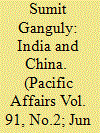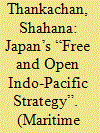|
|
|
Sort Order |
|
|
|
Items / Page
|
|
|
|
|
|
|
| Srl | Item |
| 1 |
ID:
159534


|
|
|
|
|
| Summary/Abstract |
Sino-Indian relations, which have long been fraught, took an especially adverse turn this summer with a military-to-military confrontation on the Doklam Plateau near the India-Bhutan-Tibet trijunction. After several weeks, Indian and Chinese forces withdrew from the region. However, neither side resiled from their respective territorial claims. This episode exemplified the troubles that have come to characterize the Sino-Indian relationship, especially since Prime Minister Modi assumed office in 2014. His regime, which is more nationalistic and reposes greater faith in the utility of force in international politics, had initially sought to diplomatically court the PRC in the hopes of improving their bilateral relationship. However, these efforts did not prove successful. Instead, the People’s Liberation Army, as in the past, continued to undertake limited probes along the Himalayan border, while the PRC continued to make diplomatic, commercial, and strategic inroads into India’s neighbours, trying to reduce India’s influence in those countries. The Modi regime, in turn, sought to counter these initiatives through various efforts of its own in the neighbourhood. Beyond South Asia, India has also sought to enhance its ties with Australia, Japan, the United States, and Vietnam in an attempt to hedge against the PRC’s growing economic and military assertiveness in Asia. These endeavours, however, have elicited hostile reactions from Beijing, which sees New Delhi as the only significant potential hurdle to the expansion of its influence in Asia. Despite Beijing’s adverse reactions it is unlikely that the current regime in New Delhi will scale back its efforts to cope with what it deems to be significant threats emanating from its behemoth northern neighbour.
|
|
|
|
|
|
|
|
|
|
|
|
|
|
|
|
| 2 |
ID:
157809


|
|
|
|
|
| Summary/Abstract |
Japan’s “Free and Open Indo-Pacific Strategy” was announced as recently as November 2016. However, it may be argued that Japan has been acting in accordance with this principle for over a decade in the Indo-Pacific region. While the Asia–Africa Growth Corridor and the “quadrilateral” initiative could be called the latest and more visible manifestations of this strategy, they are definitely not the first. This paper explores two core elements of the Free and Open Indo-Pacific Strategy, namel, regional connectivity and proactive contribution to peace, and highlights Japan’s initiatives in this regard in the Indo-Pacific.
|
|
|
|
|
|
|
|
|
|
|
|
|
|
|
|
|
|
|
|
|